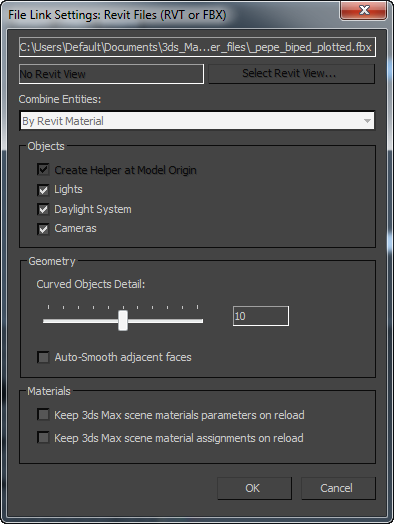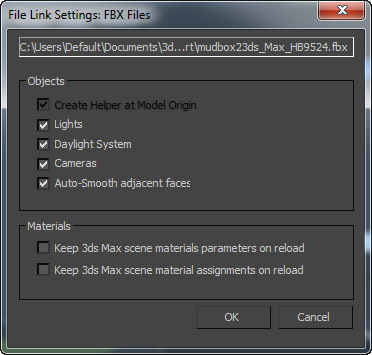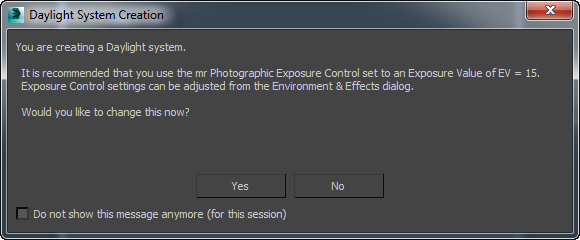This dialog appears when you reload a Revit or an FBX file, or edit the settings of a Revit or an FBX preset.
The dialog gives you control over some details of how geometry is translated from Revit and FBX files and interpreted in 3ds Max. In particular, it offers several ways to combine geometry and reduce the complexity of your 3ds Max scene, which can improve performance.
Interface

File Link Revit and FBX settings when you reload a file

File Link Revit and FBX settings when you edit a preset

File Link settings for generic Autodesk FBX files (no Combine Entities list)
- [Name field]
- When you edit a preset, this field shows the name of the preset.
When you reload a file, this field shows the path and name of the file.
- [Revit camera name]
- For RVT files, shows the name of the camera view to load.
Revit files can contain multiple camera views, but when you link a RVT file, you must choose a single camera view.
- Select Revit View
- For RVT files, click to open a list that lets you choose the camera view to load into 3ds Max.

This button is not available if there is only one camera in the RVT file, or if the file is an FBX file.
- Combine Entities list (not available for generic FBX files)
- When you edit a preset, this drop-down list lets you choose the way in which Revit entities are combined. Combining entities can reduce the number of objects in your 3ds Max scene, and improve performance.
When you reload a file, you cannot change the Combine Entities setting.
3ds Max provides these options for combining Revit and FBX entities:
- By Revit Material Revit entities assigned the same material become a single 3ds Max object. The object has the name of the material, and is placed on a layer that also has the name of the material. Revit metadata (Family and Category) does not appear in the 3ds Max Scene Explorer.
Multi/Sub-Object material information is lost.
Note: If the Revit scene does not contain material assignments, the geometry is imported as a single object, and this option becomes comparable to the As One Object option. - By Revit Category Revit entities that have the same Category become a single 3ds Max object. The object has the name of the Category and is placed on a layer that also has the name of the Category. The Family and Category appear in the 3ds Max Scene Explorer.
Multi/Sub-Object material information is retained.
- By Revit Family Type Revit entities that belong to the same Family Type become a single 3ds Max object. The object has the name of the Family Type and is placed on a layer that also has the name of the Family Type. The Family and Category appear in the 3ds Max Scene Explorer.
Multi/Sub-Object material information is retained.
- As One Object Links the entire Revit drawing as a single 3ds Max object, with the name of the camera or FBX view. The object is placed on a layer that also has the name of the camera or FBX view. Revit metadata (Family and Category) does not appear in the 3ds Max Scene Explorer.
Revit materials are combined into a single Multi/Sub-Object material.
Tip: This option is useful if you are doing a massing study such as a shadow animation. - Do Not Combine Links each Revit entity as a single 3ds Max object. This is comparable to importing an FBX file. Warning: Do Not Combine is a simple option, but if the Revit drawing is large, 3ds Max performance can suffer.
- By Revit Material Revit entities assigned the same material become a single 3ds Max object. The object has the name of the material, and is placed on a layer that also has the name of the material. Revit metadata (Family and Category) does not appear in the 3ds Max Scene Explorer.
Objects group
- Create Helper at Model Origin
- When on, 3ds Max creates a Point helper object at the origin of the linked geometry and the 3ds Max scene. The geometry is linked to the point helper, so moving the helper moves the Revit geometry. The name of the helper is the name of the RVT or FBX file (without its path). Default=on.
When you reload a file, this option is not available.
- Lights
- When on, links lights from the RVT or FBX file. Default=on. Warning: Exporting from Revit to FBX converts multiple instances of a light type to individual, unique light objects. This can dramatically reduce 3ds Max performance, and if you use the FBX format instead of RVT, we recommend that you use 3ds Max to add the lighting to an FBX model.
- Daylight System
- When on, links the daylight system from the RVT or FBX file. Default=on.
When you link a daylight system from a RVT or FBX file, the File Link Manager prompts you to turn on exposure control. This is Logarithmic Exposure Control for the Scanline renderer, or mr Photographic Exposure Control for the other visual renderers: mental ray, iray, or Quicksilver. We recommend that you click Yes. Otherwise, renderings will be overexposed.

- Cameras
- When on, links the camera from the RVT or FBX file. Default=on.
Geometry group
- Curved Objects Detail
- Controls the number of segments (the resolution) of curved objects. Default=10.
- Auto-Smooth adjacent faces
- When on, applies auto-smoothing to linked geometry. If the angle between two faces is less than or equal to 15.0, the faces are smoothed. Default=off.
Material group
- Use Scene Material Definitions
- When on, uses material definitions from the 3ds Max scene rather than materials from the Revit drawing. Default=off.
- Use Scene Material Assignments on Reload
- When on, reloading ignores material assignments in the Revit drawing and retains the material assignments from the 3ds Max scene. Default=off.